Home > Directory Home > Drawing Lessons > Drawing for Beginners >Art Materials Needed by Beginners
ART MATERIALS NEEDED : WHAT ART SUPPLIES SHOULD YOU BUY TO START DRAWING
|
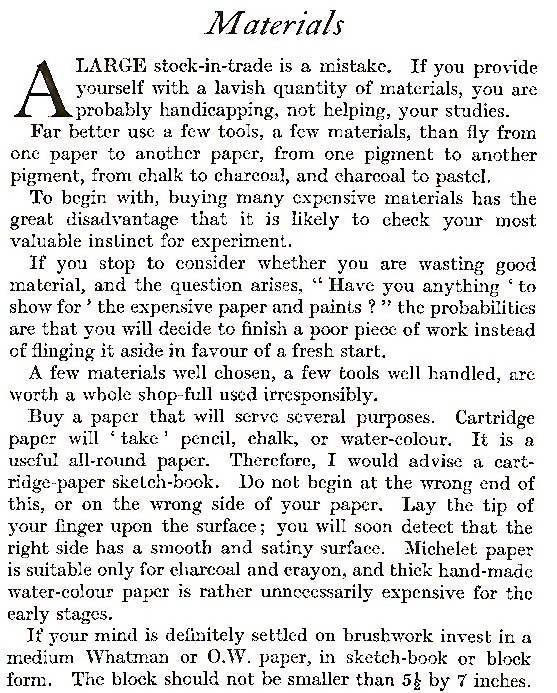
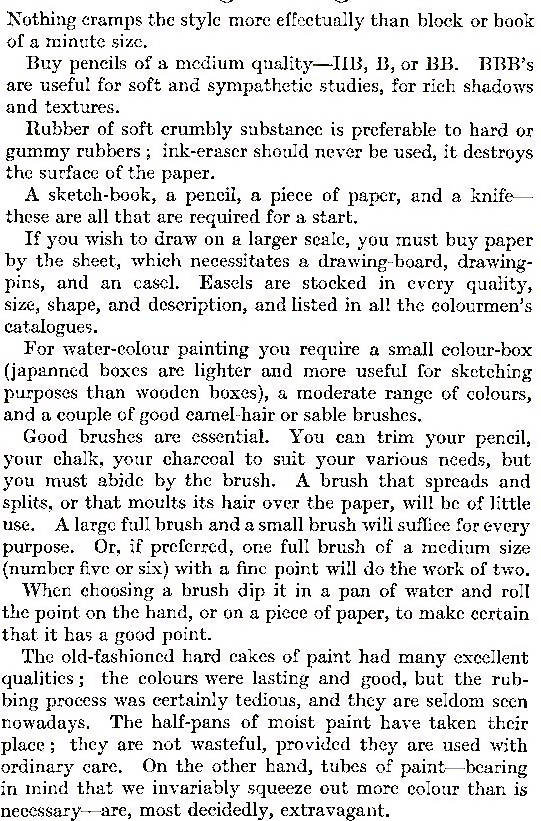
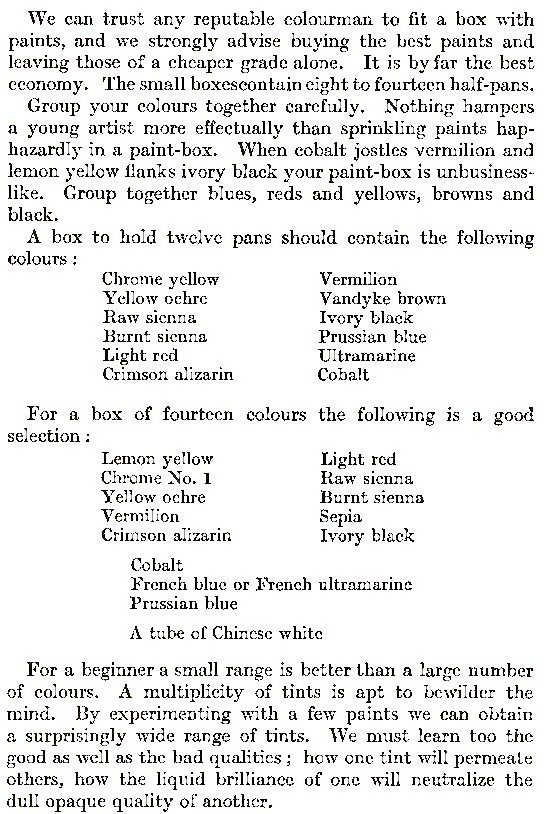
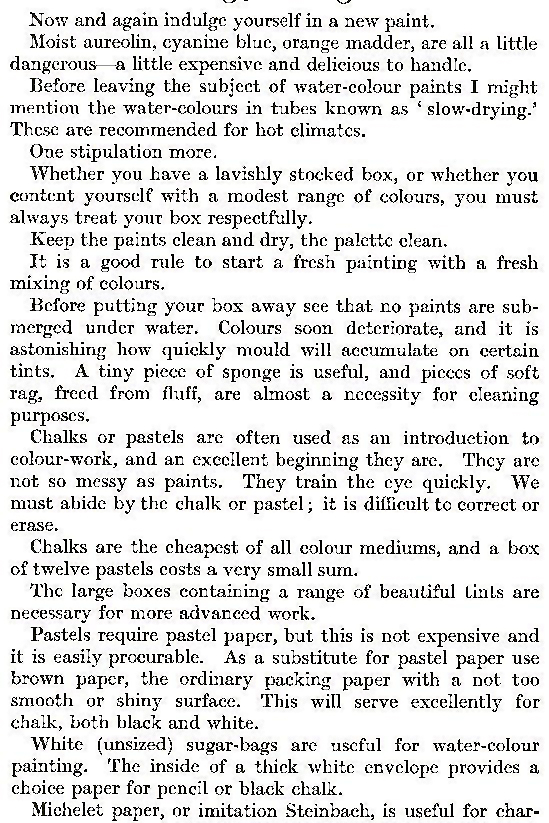
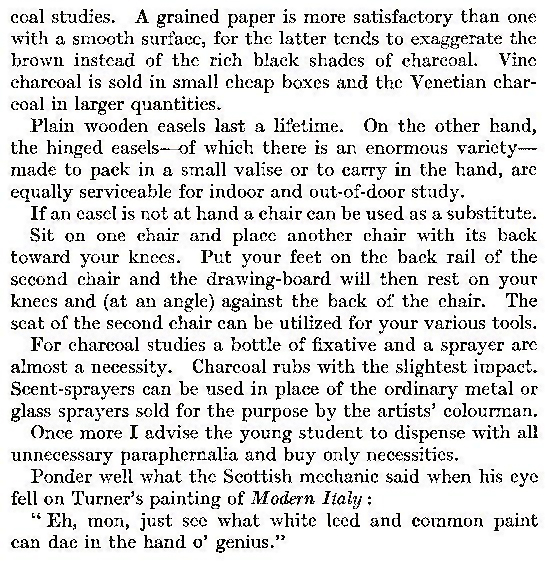
GO BACK TO THE HOME PAGE FOR TUTORIALS FOR BEGINNING ARTISTS
[The above words are pictures of text, below is the actual text if you need to copy a paragraph or two]
Art Materials Needed
A large stock-in-trade is a mistake. If you provide yourself with a lavish quantity of materials, you are probably handicapping, not helping, your studies.
Far better use a few tools, a few materials, than fly from one paper to another paper, from one pigment to another pigment, from chalk to charcoal, and charcoal to pastel.
To begin with, buying many expensive materials has the great disadvantage that it is likely to check your most valuable instinct for experiment.
If you stop to consider whether you are wasting good material, and the question arises, " Have you anything ' to show for ' the expensive paper and paints ? " the probabilities are that you will decide to finish a poor piece of work instead of flinging it aside in favour of a fresh start.
A few materials well chosen, a few tools well handled, are worth a whole shop-full used irresponsibly.
Buy a paper that will serve several purposes. Cartridge paper will ' take ' pencil, chalk, or water-colour. It is a useful all-round paper. Therefore, I would advise a cartridge-paper sketch-book. Do not begin at the wrong end of this, or on the wrong side of your paper. Lay the tip of your finger upon the surface ; you will soon detect that the right side has a smooth and satiny surface. Michelet paper is suitable only for charcoal and crayon, and thick hand-made water-colour paper is rather unnecessarily expensive for the early stages.
If your mind is definitely settled on brushwork invest in a medium Whatman or O.W. paper, in sketch-book or block form. The block should not be smaller than 5f by 7 inches.
Nothing cramps the style more effectually than block or book of a minute size.
Buy pencils of a medium quality—IIB, B, or BB. BBB's are useful for soft and sympathetic studies, for rich shadows and textures.
Rubber of soft crumbly substance is preferable to hard or gummy rubbers ; ink-eraser should never be used, it destroys the surface of the paper.
A sketch-book, a pencil, a piece of paper, and a knife—these are all that are required for a start.
If you wish to draw on a larger scale, you must buy paper by the sheet, which necessitates a drawing-board, drawing-pins, and an easel. Easels are stocked in every quality, size, shape, and description, and listed in all the colourmen's catalogues.
For water-colour painting you require a small colour-box (japanned boxes are lighter and more useful for sketching purposes than wooden boxes), a moderate range of colours, and a couple of good camel-hair or sable brushes.
Good brushes are essential. You can trim your pencil, your chalk, your charcoal to suit your various needs, but you must abide by the brush. A brush that spreads and splits, or that moults its hair over the paper, will be of little use. A large full brush and a small brush will suffice for every purpose. Or, if preferred, one full brush of a medium size (number five or six) with a fine point will do the work of two.
When choosing a brush dip it in a pan of water and roll the point on the hand, or on a piece of paper, to make certain that it has a good point.
The old-fashioned hard cakes of paint had many excellent qualities ; the colours were lasting and good, but the rubbing process was certainly tedious, and they are seldom seen nowadays. The half-pans of moist paint have taken their place ; they are not wasteful, provided they are used with ordinary care. On the other hand, tubes of paint—bearing in mind that we invariably squeeze out more colour than is necessary—are, most decidedly, extravagant.
We can trust any reputable colourman to fit a box with paints, and we strongly advise buying the best paints and leaving those of a cheaper grade alone. It is by far the best economy. The small boxescontain eight to fourteen half-pans.
Group your colours together carefully. Nothing hampers a young artist more effectually than sprinkling paints haphazardly in a paint-box. When cobalt jostles vermilion and lemon yellow flanks ivory black your paint-box is unbusinesslike. Group together blues, reds and yellows, browns and black.
A box to hold twelve pans should contain the following colours :
Chrome yellow Vermilion
Yellow ochre Vandyke brown
Raw sienna Ivory black
Burnt sienna Prussian blue
Light red Ultramarine
Crimson alizarin Cobalt
For a box of fourteen colours the following is a good selection :
Lemon yellow Light red
Chrome No. 1 Raw sienna
Yellow ochre Burnt sienna
Vermilion Sepia
Crimson alizarin Ivory black
Cobalt
French blue or French ultramarine Prussian blue
A tube of Chinese white
For a beginner a small range is better than a large number of colours. A multiplicity of tints is apt to bewilder the mind. By experimenting with a few paints we can obtain a surprisingly wide range of tints. We must learn too the good as well as the bad qualities ; how one tint will permeate others, how the liquid brilliance of one will neutralize the dull opaque quality of another.
Now and again indulge yourself in a new paint.
Moist aureolin, cyanine blue, orange madder, are all a little dangerous—a little expensive and delicious to handle.
Before leaving the subject of water-colour paints I might mention the water-colours in tubes known as ' slow-drying.' These are recommended for hot climates.
One stipulation more.
Whether you have a lavishly stocked box, or whether you content yourself with a modest range of colours, you must always treat your box respectfully.
Keep the paints clean and dry, the palette clean.
It is a good rule to start a fresh painting with a fresh mixing of colours.
Before putting your box away see that no paints are submerged under water. Colours soon deteriorate, and it is astonishing how quickly mould will accumulate on certain tints. A tiny piece of sponge is useful, and pieces of soft rag, freed from fluff, are almost a necessity for cleaning purposes.
Chalks or pastels are often used as an introduction to colour-work, and an excellent beginning they are. They are not so messy as paints. They train the eye quickly. We must abide by the chalk or pastel ; it is difficult to correct or erase.
Chalks are the cheapest of all colour mediums, and a box of twelve pastels costs a very small sum.
The large boxes containing a range of beautiful tints are necessary for more advanced work.
Pastels require pastel paper, but this is not expensive and it is easily procurable. As a substitute for pastel paper use brown paper, the ordinary packing paper with a not too smooth or shiny surface. This will serve excellently for chalk, both black and white.
White (unsized) sugar-bags are useful for water-colour painting. The inside of a thick white envelope provides a choice paper for pencil or black chalk.
Michelet paper, or imitation Steinbach, is useful for charcoal studies. A grained paper is more satisfactory than one with a smooth surface, for the latter tends to exaggerate the brown instead of the rich black shades of charcoal. Vine charcoal is sold in small cheap boxes and the Venetian charcoal in larger quantities.
Plain wooden easels last a lifetime. On the other hand, the hinged easels—of which there is an enormous variety—made to pack in a small valise or to carry in the hand, are equally serviceable for indoor and out-of-door study.
If an easel is not at hand a chair can be used as a substitute.
Sit on one chair and place another chair with its back toward your knees. Put your feet on the back rail of the second chair and the drawing-board will then rest on your knees and (at an angle) against the back of the chair. The seat of the second chair can be utilized for your various tools.
For charcoal studies a bottle of fixative and a sprayer are almost a necessity. Charcoal rubs with the slightest impact. Scent-sprayers can be used in place of the ordinary metal or glass sprayers sold for the purpose by the artists' colourman.
Once more I advise the young student to dispense with all unnecessary paraphernalia and buy only necessities.
Ponder well what the Scottish mechanic said when his eye fell on Turner's painting of Modern Italy :
" Eh, mon, just see what white leed and common paint can dae in the hand o' genius."
Privacy Policy .... Contact Us




